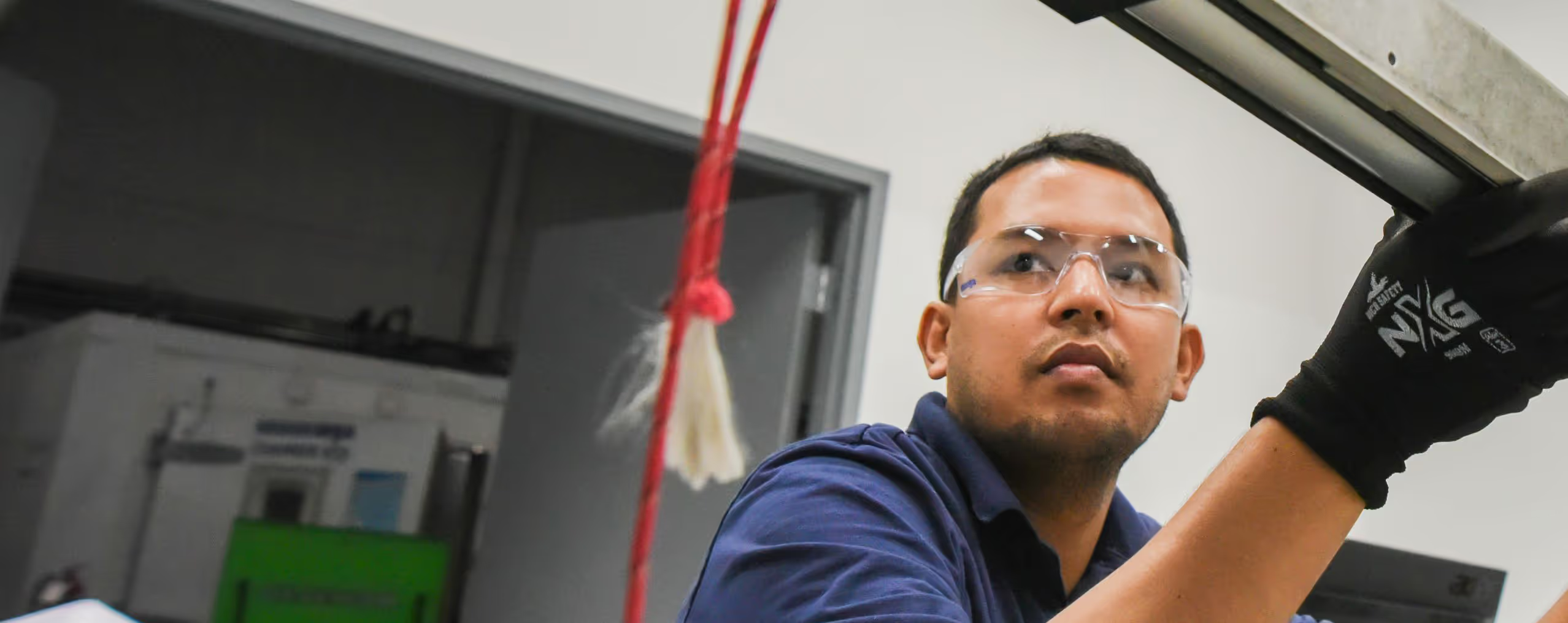
Airbag Deployment
State-of-the-art facilities featuring the latest high-speed camera technology for precise airbag deployment analysis.
Quick Overview


Equipment
Our facilities feature advanced testing equipment, including the latest high-speed camera technology and LED lighting for capturing deployment dynamics and specialized test rigs to simulate various crash scenarios.

Extreme Temperature
We offer environmental deployment testing inside specialized controlled chambers and in outdoor ambient environments, depending on your requirements.

Airbag Development
We support all phases of the airbag system development process—Development (DV), Production (PV), and Conformity of Production (COP)—to address the testing needs of the industry effectively.

Airbag Types
We provide a wide range of testing options tailored to all airbag types/locations, vehicle models, and deployment scenarios, meeting rigorous industry standards.

Technical Support
Our knowledgeable staff provides experienced technical support throughout the testing process, helping optimize procedures and address any challenges that arise.
.avif)
Local Support
Our ISO 17025 accredited facilities are strategically located across North America, ensuring efficient and accessible airbag testing services for all our clients.
Airbags are a critical component of modern vehicle safety systems, designed to protect occupants in the split second of a crash. To ensure these systems perform reliably under all conditions, manufacturers and suppliers rely on rigorous testing. At MGA Research, we support many stages of airbag development, from early prototypes to production validation. This is achieved through a comprehensive range of test methods, equipment, and expertise.
How Airbag Deployment Testing Works
Understanding Airbag Systems
Airbags operate on precise engineering principles. Deployment occurs within milliseconds, triggered by deceleration sensors integrated into a vehicle’s safety network. These systems must balance rapid inflation with controlled force to minimize injury while working seamlessly alongside seat belts and other restraints.
The Testing Process
Before any test, vehicles or components undergo careful preparation. Sensors are installed and calibrated, high-speed cameras are positioned to capture deployment from multiple angles, and data acquisition systems are configured to record critical performance metrics.
Static Testing
In addition to dynamic crash scenarios, static airbag deployment testing plays a key role in system validation. This method uses deployment times provided by suppliers or determined from earlier test data, allowing airbags to be fired in a controlled environment without a full crash event. Static tests verify that the system inflates within the required time window and achieves proper coverage.
A major advantage of static testing is the ability to evaluate performance under extreme environmental conditions. Airbags are deployed in chambers ranging from -35°C to +90°C, ensuring consistent operation in both freezing cold and high-heat climates. This helps validate long-term reliability across real-world conditions.

Types of Airbag Testing
- Front Airbags: Testing driver and passenger airbags, including steering wheel and dashboard-mounted systems.
- Side Impact Systems: Evaluating seating side, curtain airbags, and door mounted systems for both collision and rollover scenarios.
- Specialized Systems: Knee airbags, rear passenger protection, pedestrian airbags, and multi-stage deployments require unique validation methods.
Testing Equipment and Technology
- High-Speed Cameras: Capture deployment at extremely high frame rates, ensuring accurate analysis of inflation sequence and coverage.
- High Intensity Lighting: To capture airbag deployments at a extremely high frame rate, high intensity LED lighting systems are used to ensure every detail is visible.
- Crash Test Configurations: From sled testing individual components to full-scale crash scenarios and out-of-position deployments.
- Data Acquisition Systems: Measure temperature, timing, and voltage to verify with design and regulatory requirements.
Testing Standards
Airbag systems must meet strict safety regulations and OEM specifications. MGA conducts airbag testing in line with:
- FMVSS Requirements: U.S. federal standards for timing, occupant positioning, and low-risk deployment.
- OEM Specifications: Manufacturer-driven protocols, including integration with seat belt systems and warning indicators.
- ISO Accreditation: ISO 17025 quality standards ensure reliable, traceable, and accurate test results.
Environmental Testing Conditions
Airbags must perform in all environments. MGA uses advanced environmental chambers to simulate extreme conditions such as high heat, freezing cold, humidity, and long-term aging cycles, ensuring reliable deployment in real-world scenarios.
Development Phase Support
MGA supports testing throughout the product lifecycle:
- Development Validation (DV): Prototype evaluation and iterative testing for design improvements.
- Production Validation (PV): Ensuring production-intent parts meet safety and quality requirements.
- Conformity of Production (COP): Ongoing testing for long-term reliability and regulatory quality assurance.
Safety Analysis and Reporting
Post-test analysis is just as important as the deployment itself. MGA evaluates:
- Performance Metrics: Inflation timing, pressure curves, force mapping, and coverage area.
- Occupant Protection: Injury criteria, child safety considerations, and out-of-position scenarios.
- System Integrity: Module strength, tear seam quality, and residue assessment.
Multi-Location Testing Capabilities
With regional facilities, MGA offers flexibility and convenience for clients. Coordinated testing across locations provides resource optimization, faster timelines, and unified reporting.
Airbag testing locations:
- Lincoln, Alabama
- Ontario, Canada
- Hughson, California
- Troy, Michigan
- Greer, South Carolina
- Irving, Texas
- Burlington, Wisconsin
Why Choose MGA for Airbag Deployment Testing
- Technical Expertise: Decades of hands-on experience and problem-solving support across the industry.
- Comprehensive Capabilities: From front airbags to specialized systems, across every development phase.
- Industry Partnerships: Trusted relationships with OEMs, suppliers, and regulatory bodies.
At MGA Research, we combine technical expertise, advanced equipment, and proven processes to deliver reliable, accurate, and comprehensive airbag deployment testing. This includes both controlled static deployments or dynamic crash scenarios.

Ready to Get Started?
Let's discuss your testing needs and how MGA can help. Our team is ready to provide the expertise and solutions you're looking for.
